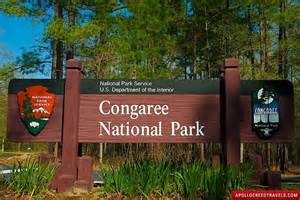Water quality study conducted in Congaree National Park
October 12, 2017A recent study conducted by the United States Geological Survey (USGS) focused on water quality at Congaree National Park has been published and is one of many tools utilized by park staff to manage the resources of Congaree National Park.
The study was requested by the park to better understand the frequency of organic chemical contaminants such as pesticides and pharmaceuticals found in the protected waters of Congaree National Park. Pesticides and pharmaceutical chemicals originate from human and agricultural sources and are frequently found in waters throughout the country. “Congaree National Park, like other parks around the country, is positioned in a landscape where surrounding land uses, municipal wastewater discharges and on-site visitation can potentially introduce contaminants into the protected areas,” said Paul Bradley, USGS Research Ecologist/Hydrologist and lead author of the study. “Our main goal with this study, which was requested by the National Park Service, was to provide key information to help park managers understand the potential sources of a variety of water contaminants detected in protected areas.” The report did conclude that certain chemicals were present in some park waterways but that they did not pose a threat to park visitors.
The study involved sampling from a wide range of aquatic sites throughout the park. Findings of the study indicate that, while found at very low levels, some of the chemicals were found in interior lakes and creeks which suggests that they came from human activity. Many of the chemicals could have adverse effects if the levels were to increase. “Managing the resources at Congaree National Park involves a lot of teamwork,” said Park Superintendent Tracy Stakely, “We continue to work with National Park Service scientists, USGS and park partners to monitor the water quality in the park. It is also important to understand the potential impact that humans can have near the park’s water resources. Scientific research such as this will continue to serve as a basis for future management and education strategies that may be implemented to protect park resources.”
This study supports other initiatives geared toward managing park resources. National Park Service (NPS) scientists from the regional based Southeast Coast Inventory and Monitoring Network (SECN) conduct valuable testing and research that includes the collection of basic water chemistry data. Park resource management staff work closely with SECN and other scientists to coordinate efforts to monitor water quality and research in the park. The Old Growth Bottomland Forest Research and Education Center (OGBFREC) is based at the park and supports expanding water resources research as well as efforts to support increased water monitoring efforts at the park. Park staff continue to work with partners to ensure that the resources at the park are protected and safe for visitors.
For additional information about the study please visit http://onlinelibrary.wiley.com/doi/10.1002/etc.3873/.
For information about Congaree National Park please visit the park website at www.nps.gov/cong or call the Harry Hampton Visitor Center at (803) 776-4396.
Join Congaree National Park on social media: www.facebook.com/CongareeNP and www.twitter.com/CongareeNPS
















